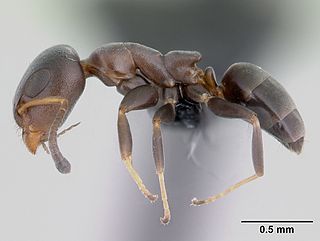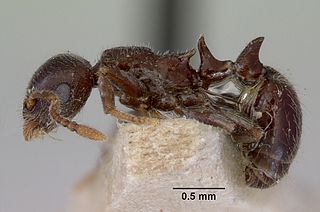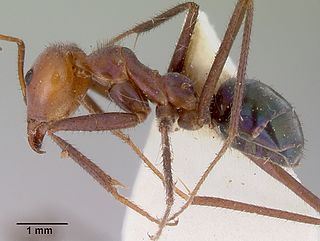
Ponerinae is a subfamily of ants in the Poneromorph subfamilies group, with about 1,600 species in 47 extant genera, including Dinoponera gigantea - one of the world's largest species of ant. Mated workers have replaced the queen as the functional egg-layers in several species of ponerine ants. In such queenless species, the reproductive status of workers can only be determined through ovarian dissections. Ponerinae is a subfamily of ants within the family of Formicidae. These ants typically nest in soil, forest litter, or rotting logs, and are predacious. They primarily prey on isopods. They mostly live in small colonies of up to 200 workers. They can be found mostly in tropical environments, but have been found in southeastern Canada and New York. Female workers have twelve segmented antennae, whereas male workers have 13 segmented antennae.

Dolichoderinae is a subfamily of ants, which includes species such as the Argentine ant, the erratic ant, the odorous house ant, and the cone ant. The subfamily presents a great diversity of species throughout the world, distributed in different biogeographic realms, from the Palearctic, Nearctic, Afrotropical region and Malaysia, to the Middle East, Australian, and Neotropical regions.

Turneria is a genus of ants that belongs to the subfamily Dolichoderinae. Known from Australia, they form small colonies of fewer than 500 workers, and nest in trees and twigs.

Iridomyrmex, or the rainbow ant is a genus of ant first described by Austrian entomologist Gustav Mayr in 1862. He placed it in the subfamily Dolichoderinae of the family Formicidae. There are 79 described species and five fossil species. Most of these ants are native to Australia; others are found in Asia and Oceania, and they have been introduced to Brazil, New Zealand and the United Arab Emirates. Fossil species are known from China, France and the United States.

Myrmecina is a genus of ants in the subfamily Myrmicinae. It contains 51 species distributed in North America, Europe, northern Africa, India east, Korea, Japan and Australia.

Ochetellus is a genus of ants first described by Steve Shattuck in 1992. He placed it in the subfamily Dolichoderinae of the family Formicidae. The ants in this genus are small and black in colour; workers measure 1.75 to 3 millimetres in length, the males at around 1.6 millimetres (0.06 in) are smaller, and the queens are the largest, reaching 4 millimetres (0.16 in). There are seven described species and three described subspecies that mostly live in Australia in a wide variety of habitats, but some species are found in Asia. One species, Ochetellus glaber, has been introduced into New Zealand and the United States.

Colobostruma is a genus of ants in the subfamily Myrmicinae. All except one species are restricted to Australia. The only non-Australian species, C. foliacea, is found in New Guinea and the Solomon Islands.

Peronomyrmex is a rare genus of ants in the subfamily Myrmicinae. Its three species are known from the east coast of Australia. With only five specimens in total, collected from four localities, Peronomyrmex is one of the world's most rare ant genera.

Iridomyrmex galbanus is a species of ant in the genus Iridomyrmex. Described by Shattuck in 1993, the ant is mainly confined to the Eyre peninsula in South Australia, but other populations of the species have been identified in several other states in Australia.

Iridomyrmex lividus is a species of ant in the genus Iridomyrmex. Described by Shattuck in 1993, the ant is endemic to Australia and resembles a similar appearance to the Meat ant.
Iridomyrmex phillipensis is a species of ant in the genus Iridomyrmex. Described by Heterick and Shattuck in 2011, the ant is the only species endemic to Australia to not actually live in the country itself, but instead lives in territory that belongs to Australia.
Iridomyrmex setoconus is a species of ant in the genus Iridomyrmex. Described by Shattuck and McMillan in 1998, the species is endemic to Australia, and small populations have only been found in Esperance.
Turneria arbusta is a species of ant in the genus Turneria. Described by Shattuck in 1990, the species is endemic to Papua New Guinea.

Turneria bidentata is a species of ant in the genus Turneria. Described by Forel in 1895, the species is endemic to Australia, mostly found in the north ends of the country.
Turneria collina is a species of ant in the genus Turneria. Described by Shattuck in 1990, the species is endemic to Papua New Guinea.
Turneriapostomma is a species of ant in the genus Turneria. Described by Shattuck in 1990, the species is endemic to Papua New Guinea.
Turneria dahlii is a species of ant in the genus Turneria. Described by Forel in 1901, the species is endemic to New Guinea, the Solomon Islands and Vanuatu.
Turneria frenchi is a species of ant in the genus Turneria. Described by Forel in 1911, it is endemic to Australia, but original specimens of the ant have been lost, and its placement in a genus has been in question. The ant has been transferred various times, notably being transferred to Stigmacros in 1990 but then put back into Turneria in 1992.

Turneria pacifica is a species of ant in the genus Turneria. Described by William M. Mann in 1919, the species is endemic to the Solomon Islands and Vanuatu.










